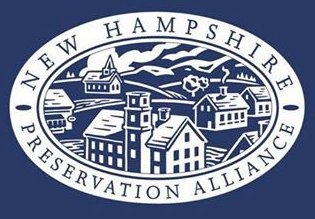Historic Preservation Easement for the Hilliard-Prescott House, Kensington
Historic Preservation Activity Caps and Celebrates Recent Restoration
Long-time Kensington resident Elaine (Prescott) Kaczmarek has added a historic preservation easement to her property, the Hilliard-Prescott House, to meet her stewardship goals. This historic preservation activity caps and celebrates her recent, comprehensive rehabilitation and restoration of this property that has been in her family for generations. As planned, Kaczmarek is now looking for a new owner for the historic property.
The c. 1810/20s late Federal/Greek Revival style house and mid-19th century barn are significant as well-preserved nineteenth-century rural village buildings that retain a high degree of their architectural integrity from their nineteenth-century construction periods, and for their association with the Hilliard and Prescott families who played significant roles in the small-scale manufacturing, commercial, cultural, and social history of Kensington for over 150 years. The property is located in what was known historically as the Lower Village, at the southern end of the Kensington Town Center and is a significant component of the well-preserved collection of nineteenth-century residential, religious, and cultural buildings that are characteristic of a rural New Hampshire town.
From left, property owner and easement donor Elaine Kaczmarek, Preservation Alliance director Jennifer Goodman, Preservation Alliance board member Lorraine Merrill, and former board member and Kensington Heritage Commission chair Lynne Emerson Monroe at the house on the day of the easement document completion.
The easement, held by the N.H. Preservation Alliance, prohibits demolition of the historic structures and offers guidance to protect major architectural and site features while allowing flexibility for changes. The terms of the easement are in the property's deed and continue with owners after Kaczmarek.
“The Kensington Heritage Commission is very grateful to Elaine for preserving one of the key buildings in our National Register historic district. We hope her action will be an inspiration for others,” said Lynne Emerson Monroe, chair of the Commission. The Commission serves a planning, educational and promotional role for the Town. The recent National Register historic district designation of Kensington village that includes the Hilliard-Prescott property is an honorific status that does not afford the protection of an easement.
Kaczmarek, a leader of civic and heritage activities in town, had also previously donated a conservation easement to the Southeast Land Trust of New Hampshire, and preservation easements on two historic family properties in Kensington’s Prescott Corner to the Preservation Alliance.
The Preservation Alliance is a 39-year old statewide non-profit organization with a growing portfolio of preservation easements.
Preservation easements have been used since 1955 and there are now thousands in place throughout the country. They provide protections and a review process for certain alterations, and in a process that is similar to that provided by local historic district commissions. Many potential buyers have already had experiences with these commissions, live in historic districts, have rehabilitated historic buildings, or appreciate the history of older buildings. Property owners value the on-going technical help and assistance that is part of the easement relationship.
For more information on preservation easements and statewide preservation activities contact executive director Jennifer Goodman, N.H. Preservation Alliance at 603-224-2281 or jg@nhpreservation.org.
More on the social history significance of the Hilliard-Prescott property:
According to research prepared by Preservation Company, The Hilliard-Prescott property has been intricately linked with the descendants of the Hilliards and the Prescotts, who first settled in Kensington in the eighteenth century. Since the house’s construction in the first quarter of the nineteenth century, the property has been owned and occupied by different generations of just those two families. The property has not only served as the home for multiple generations but in the nineteenth century was also the site of their livelihood while also frequently being a well-known meeting spot for town residents because of the Hilliards’ and Prescotts’ active engagement in town institutions and organizations. The gatherings occurred in the house or in the store in the rear ell. The men served as selectmen, state representatives, and as Justices of the Peace, in addition to being actively involved in religious groups. One Hilliard was instrumental in the organization of the First Universalist Society in 1865. A number of the women were also actively involved in religious groups but also played major roles in the establishment and flourishing of the local library just a stone’s throw from the house.
You can view the realtor’s listing here.


